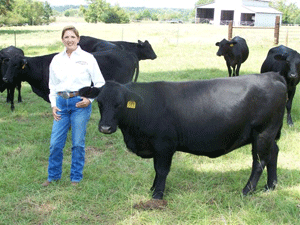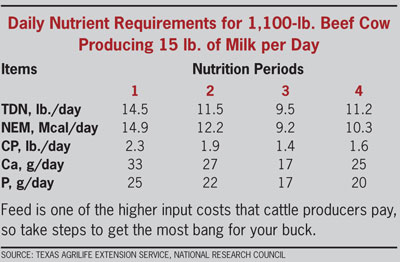Think Outside the Hay Ring

 |
| Do some critical thinking before you cut back feed supplies, advises Ron Gill, a livestock specialist at Texas A&M University. There may be other ways to keep feed costs in check. |
Continuing drought conditions and rising input costs are forcing many ranchers to reconsider feeding strategies and even step back and look at overall production goals for their cow herds.
East Texas rancher Linda Galayda is one rancher making adjustments in her cattle operation to keep the books balanced. She knows her cost of production and knows there are certain areas within that cost where she can make adjustments. The main thing is, she has a plan and knows where she can and can't afford to make cuts.
It's easy to go in and just start cutting back on feed, mineral and other purchases. Sometimes, however, those cuts can actually cost you more money in the long term.
"Do not start cutting costs first, and then start thinking about the ramifications," warns Ron Gill, livestock specialist at Texas A&M University.
When considering supplemental feed, Gill says, look at the bigger picture. Ask yourself these questions:
- Are you certain that you are using the optimal feed for your situation?
- Is your stocking rate in line with your forages' production potential?
- Do your cows match your environment?
- Is your calving season in sync with forage?
Once you answer these questions, you can begin looking at areas to reduce feed costs.
| Bonus Conent: |
|---|
| Click here to go to the University of Missouri By-Product Feed Price Listing. Follow this link to read about ways to reduce feedlot costs from Iowa State University. Follow this link to "Surviving Higher Imput Costs: Improving Efficiency," a presentation by Ron Gill at the 2008 Texas A&M Beef Cattle Short Course. Read more about "What Does a Cow Need? A Review of Nutrient Requirements."
|
For example, Galayda looked at her entire operation to determine where she could make cuts that would make sense for her ranch, Jordens Cattle Company near Elkhart, Texas.
She's also evaluating whether to discontinue some of her traditional practices in order to reduce inputs and risks. For instance, in normal years, she has planted rye grass for winter pasture. This year, however, she's decided to forgo that option due to the inconsistency in rainfall.
"I can't afford to make mistakes, and our weather is so sporadic, I didn't want to spend the money planting and then have it not rain," she says. Next year she plans to reevaluate the option because it offers a good source of winter grazing. But it was a cut she could make that didn't impact production and growth this year.
While you're looking at the bigger picture, consider these other strategies to reduce feed costs.
Wean early. This is a practice often recommended during drought years. It also is a good strategy to reduce feed requirements for the herd when feed prices are high. Galayda took advantage of the idea and sold off calves 30 days earlier than normal this year.
Since she removed calves early, she reduced the nutritional needs of lactating cows, so nutrients went to improve body condition rather than producing milk. Her cows are now at a body condition score of 6 or higher, so cow supplementation requirements going into the fall will be significantly reduced.
 |
| East Texas rancher Linda Galayda plans to cut back on the number of first-calf heifers in the herd by 60% and the number of replacement females by 50%. |
Change culling strategy. Now is the time to scrutinize the herd for non-producing or low-producing cattle, says Daryl Strohbehn, an Iowa State University Extension beef specialist. Not only eliminate open cows, but also consider culling cows with bad udders, late-calving cows and cows with poor dispositions.
"Your goal should be to use your feed resources for cows that have the best chance of producing a profitable calf next year," Strohbehn says.
Cut back on herd replacements. Not only is Galayda culling the herd by nearly 100 head this year, she's also cutting back on the number of first-calf heifers in the herd by 60% and the number of replacement females by 50%.
That's because younger replacement animals often need to be on a higher nutritional plane compared to older brood cows in the herd that can often get by on lower-quality forage and feeds.
"This is a short-term fix, but my plan is to look this spring at buying replacements rather than carrying those animals through winter," Galayda says.
She prefers using her own genetics and raising heifers in their environment, but sometimes there are decisions that have to be made to get through a tough year or two. "For now, this has reduced stocking rates," she explains.
Shop early and check often for feed supplies. With high hay and feed costs, it's definitely a time to shop around and be prepared to lock in deals when prices are favorable, Strohbehn says.
"When feed supplies are tight, prices of commonly needed feeds increase dramatically," he says. "So you need to look at various methods to balance on-farm feed supplies with the herd's needs."
Just make sure you have a dry place to store feed to prevent waste. Galayda bought her hay last year when prices were reasonable, and has been storing it.
Since it's been in storage longer, she's testing it to adjust supplements as necessary. She also checks prices and contracts supplements (protein cubes) to get the best price. When doing that, however, be mindful of freight charges to determine the best deal.
Byproducts, coproducts and corn stalks are all good options. The key is to analyze the feed source, ask questions about quality and look at all the costs associated with the price quote, including freight.
Wet and dry distillers' grains are another alternative for supplemental feed if they are available in your area. Strohbehn says these feeds generally run about 30% crude protein and contain more energy. They also have a high fiber content, typically around 48% neutral detergent fiber (NDF).
Prevent feed waste. If you roll out hay to cows, be careful not to put out too much at one time. "Feeding more than one day's supply results in substantial feed waste," Strohbehn says.
Delivery cost is another area to watch, Gill warns. "We have producers trying to figure out ways to reduce the machinery necessary to feed cows and reduce the number of trips to the pasture to deliver hay or supplement."
He points to research that shows delivering protein supplements to the herd once a week is more efficient. It also results in improved consumption across all cattle in the herd as well as improved body condition and breeding rates. "All of this was a result of more uniform consumption of protein supplements when more pounds were fed at each feeding," Gill says. "Less aggressive cows had increased opportunity to consume supplement."
Also, make sure hay rings, panel feeders and portable feed bunks are in good shape so that feed doesn't end up on the ground to be trampled by the cattle.
"Tub-grinding feeds and combining total mixed ration (TMR) and feeding in bunks, tires or other types of feeders dramatically reduces feed waste and can lower winter feed bills," Strohbehn says. Another benefit is that tub-grinding poor-quality forages improves feed intake and makes it more feasible to supplement with better-quality forages in a TMR.
Don't skimp on nutrition. Know your cows' nutrient requirements up front and understand what deficiencies may exist in your herd. (See chart with guidelines from the National Research Council).
One area of nutrition many producers may be thinking of cutting back on is mineral supplements. You can make that choice, but it might cost you down the road in terms of lost performance, says Dennis Herd, a retired Texas A&M University Extension nutritionist.
Galayda refuses to cut back on her mineral program. "I have spent a lot of time learning about the role minerals and nutrition play in reproduction," she says. Right now she has a 92% breed-back rate and doesn't want to make cuts on the mineral program only to have that rate reduced. In the end, the short-term savings may significantly impact long-term production.
Watch nutrient requirements. Matching stages of production to forage growth can reduce the cost of additional feed. A shorter calving season reduces supplemental needs by keeping the herd at the same production stage throughout the year.
Remember the biological priorities for nutrients: maintenance, growth, milk production and reproduction. When a cow is in all four stages at once, it is critical that her nutritional needs are met, otherwise production in those areas will suffer.
Typically, spring provides higher-quality grazing forages, while quality declines in late summer and fall. Lush spring growth in that case should coincide with calving season. That is the most nutritionally demanding time for a cow. Abundant feed supplies allow the cow to meet nutrient requirements while nursing and improve body condition going into breeding season.
The key to lower feed bills is to carefully analyze your operation to find ways to strategically make cuts that won't be detrimental to production. BT
Precise Nutrients
Period 1—Postpartum, open and lactating. Cows in this stage are at the most nutritionally demanding level.
Period 2—Pregnant and lactating. During this 120- to 130-day period, nutrient requirements remain relatively high, but protein and energy needs are lower than in period 1.
Period 3—Mid-gestation, dry. This period follows weaning and is the time when nutrient requirements are at their lowest.
Period 4—Late gestation, dry. This is when the majority of fetal growth occurs. Cows at this stage will need to maintain a body condition score of 5 or 6 to ensure the birth of healthy calves and the ability to breed back quickly. 
To contact Kim Watson, e-mail kwatson@farmjournal.com.







